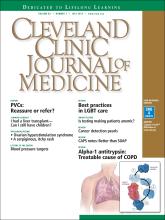to the editor: I read with great interest the article by Thomas et al, “Interpreting SPRINT: How low should you go?”1
Hypertension is the most prevalent modifiable risk factor, affecting almost one in every three people in the United States.2 Moreover, only half of people with hypertension have their blood pressure under control to the current standard of lower than 140/90 mm Hg.2 The Systolic Blood Pressure Intervention Trial (SPRINT) tested a lower goal systolic pressure, ie, less than 120 mm Hg, and found it more beneficial than the standard goal of less than 140 mm Hg.3
A drawback of SPRINT that Thomas et al did not address in their interpretation of the trial is that the two study groups were not homogeneous in terms of the antihypertensive drugs used. Antihypertensive drugs do not only lower blood pressure—some of them have additional pleiotropic effects, making their use more advantageous in special situations. For example, renin-angiotensin-aldosterone system (RAAS) blockers—ie, angiotensin-converting enzyme inhibitors, angiotensin II receptor blockers, and mineralocorticoid receptor antagonists—are disease-modfying drugs in heart failure, as are certain beta-blockers.4 The cardiovascular benefit seen in the intensive-treatment group in SPRINT compared with the standard-therapy group was primarily due to a reduction in heart failure (a 38% relative risk reduction, P = .0002),3 for which RAAS blockers and beta-adrenergic blocking drugs have been shown consistently to be beneficial. But the intensive- and standard-therapy groups were not homogeneous in terms of the use of RAAS blockers and beta-blockers.
So, was the cardiovascular benefit attained in the intensive-treatment group in SPRINT due to the benefit of lower blood pressure or to the drugs used?
- Copyright © 2016 The Cleveland Clinic Foundation. All Rights Reserved.






